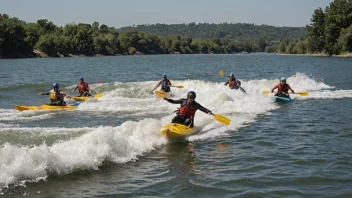Engaging in water sports can be exhilarating and invigorating, but it also comes with its own set of risks and potential emergencies. This article will guide you through the recognition of various water sports emergencies and provide you with clear steps on how to respond effectively. By learning these essential skills, you can ensure not only your safety but also the safety of others while enjoying your favorite aquatic activities.
Step 1: Recognize the Signs of Distress
Before you can respond to a water sports emergency, you need to be able to identify the signs of distress. Look for the following indicators:
- Struggling Swimmer: Watch for erratic movements, splashing, or a swimmer who is unable to keep their head above water.
- Unresponsive or Unconscious Individuals: If someone is floating face down or not moving, they may be in trouble.
- Signs of Fatigue: Frequent treading water, a swimmer who is holding on to equipment, or someone who is calling for help can all indicate distress.
- Equipment Issues: Look for capsized kayaks, flipped surfboards, or broken safety gear that may indicate a problem.
Step 2: Assess the Situation
Once you have identified a potential emergency, it is crucial to assess the situation before taking action. Consider the following:
- Distance: Determine how far away the person in distress is from you and the shore.
- Conditions: Evaluate the water conditions, including currents, waves, and visibility.
- Number of People: Assess whether there are multiple individuals in distress or if it is a singular incident.
- Personal Safety: Always prioritize your own safety. Do not put yourself in harm's way to assist someone else.
Step 3: Call for Help
In emergencies, time is of the essence. If you recognize a water sports emergency, do not hesitate to call for help:
- Use a mobile phone: If you are near a beach or area with cell service, call local emergency services immediately.
- Alert Lifeguards: If there are lifeguards present, signal them immediately as they are trained to handle such situations.
- Use Whistles or Signals: If you are part of a group, use whistles or other signaling devices to alert others to the emergency.
Step 4: Provide Assistance
If it is safe to do so and you are trained in water rescue techniques, you can provide assistance:
- Throw, Don’t Go: If the person is too far away or if the conditions are dangerous, throw them a buoy, rope, or any floating object to help them reach safety.
- Use Your Equipment: If you are on a surfboard, kayak, or jet ski, maneuver close enough to provide support without risking your own safety.
- Stay Calm: Encourage the distressed swimmer to remain calm, as panic can worsen the situation.
Step 5: Perform Rescue Techniques (If Trained)
If you are properly trained and it's safe to approach the individual in distress, you may need to perform rescue techniques:
- Reach: Extend a hand or a paddle to the person, keeping your body low to avoid being pulled in.
- Row: If you are in a boat, row towards the person while keeping your eye on their movements.
- Go: (Last Resort) If the situation demands and you have the skills, enter the water to assist. Ensure you have a flotation device to aid both yourself and the person in distress.
Step 6: Provide First Aid
After the individual is brought to safety, assess their condition:
- Check for Breathing: If they are unconscious, check for breathing and pulse. Be prepared to perform CPR if necessary.
- Warmth: If they are cold, remove wet clothes and wrap them in a warm blanket.
- Seek Medical Attention: Regardless of their condition, it’s wise to have them evaluated by a medical professional.
Step 7: Report the Incident
After the emergency has passed, ensure that the incident is reported to the appropriate authorities. This step helps improve safety protocols and awareness in the area.
- Documentation: Write down details of the incident, including time, location, and any witnesses.
- Inform Local Authorities: Notify local water safety officials to prevent future incidents.
By taking these steps, you will not only increase your awareness of water sports emergencies but also enhance your ability to respond effectively and potentially save lives.
In summary, recognizing the signs of distress, assessing the situation, calling for help, providing assistance, performing rescue techniques (if trained), offering first aid, and reporting the incident are essential steps in managing water sports emergencies. Always prioritize safety and stay informed about best practices in water rescue.






